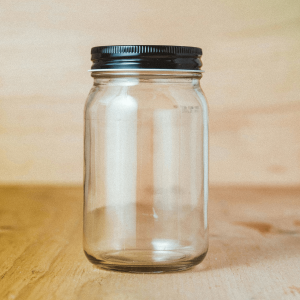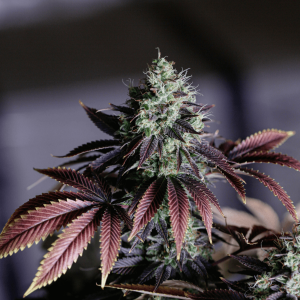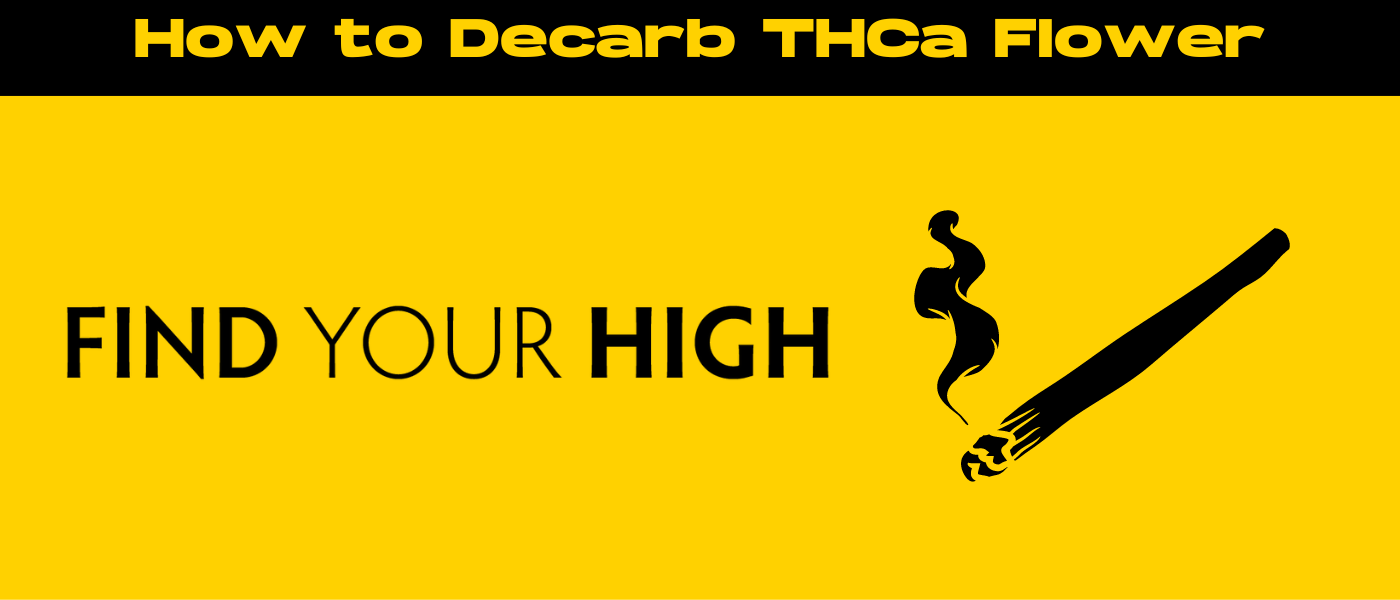In the world of cannabis science, understanding how to decarb THCa flower is crucial for those looking to unlock the full potential of their hemp.
If you’re unfamiliar, decarboxylation is a chemical reaction that occurs when cannabis is exposed to heat, light, or certain solvents, effectively transforming the non-psychoactive THCa into the potent psychoactive compound we all know and love — THC.
The decarboxylation process is not just crucial for people looking for the therapeutic and mood-altering effects of THC, but also for those who want to precisely consume and dose hemp for medical purposes.
As we dive deeper into this topic, our blog will explore the intricacies of decarboxylation, underlining its importance in converting THCa to its active form. You’ll learn about the various methods used to decarb cannabis flower, the science behind the transformation, and tips for achieving maximum efficiency. Let’s get started!
Understanding THCa
Tetrahydrocannabinolic acid (THCa) is a non-psychoactive cannabinoid found in the raw cannabis plant. Considered the acidic parent molecule of THC, THCa is present in high concentrations in fresh, undried cannabis flowers.
It’s only when THCa is exposed to heat, a process known as decarboxylation, that it converts into the psychoactive THC. Simple enough, right?
The Difference Between THCa and THC
The main distinction between THCa and THC is in their molecular structure and the psychological effects they produce.
THCa is non-psychoactive because it does not effectively bind to CB1 receptors in the human brain. THC, on the other hand, has undergone decarboxylation, losing a carboxyl group, which allows it to interact with these receptors and produce psychoactive effects.
Benefits of THCa Flower
THCa flower has its own benefits, primarily attributed to its state before decarboxylation.
Some studies suggest that THCa has both anti-inflammatory and neuroprotective properties, which can be beneficial for medical marijuana patients with certain medical conditions.
Furthermore, consuming raw THCa flower allows individuals to receive the benefits of cannabinoids without getting high. This offers an option for those wanting to avoid the intoxication that THC produces, provided that decarboxylation doesn’t take place.

The Science Behind Decarboxylation
Decarboxylation might seem like a complex process, but at its core, it involves relatively simple chemistry.
When THCa, which has a carboxyl group (-COOH) attached to its molecule, is heated, it loses a carbon atom and two oxygen atoms (a process known as losing CO2, or carbon dioxide). This transformation, from THCa to THC via smoking or vaping cannabis, is what activates the cannabinoid’s psychoactive effects.
Chemical Changes During the Decarb Process
During the decarb process, the heat causes the cannabinoids in cannabis to react—the carboxyl group is released from the THCa molecule in the form of water vapor and carbon dioxide.
This chemical reaction alters the cannabinoid’s ability to interact with the body’s endocannabinoid system. While THCa does not readily bind to CB1 receptors, THC, its decarboxylated form, fits like a key in a lock, allowing the psychoactive effects to take place.
How Decarb Affects Potency and Effects
The potency of THC in cannabis is directly affected by how thoroughly it’s been decarboxylated. Incomplete or improper decarboxylation can result in less powerful effects, as some of the THCa remains unconverted and non-psychoactive.
By perfecting the decarb process, we can achieve maximum potency, leading to a more consistent and enjoyable experience.
When it comes to effects, decarboxylated cannabis interacts with the body in a different way than THCa. We all know THC can bring on some interesting experiences, from feeling euphoric and relaxed to having a heightened sense of perception.
On the flip side, researchers are looking into the effects of THCa, specifically its potential medical benefits without getting you high. By understanding decarboxylation, you can customize your experience for the effects you want, whether it’s for fun or for relief.
Preparing to Decarb THCa Flower
Before you can even start transforming THCa into THC, there are several key prep steps to ensure the best outcome:
- Selecting Quality THCa Flower: It’s essential to start with high-quality THCa flower to ensure that your decarb process yields potent THC. Look for flowers with a vibrant color, a strong aroma, and no signs of mold or pests. Additionally, be sure to only purchase from trusted sources, such as Hyperwolf.
- Necessary Tools and Equipment: The decarboxylation process requires specific tools for efficiency and safety. You’ll need a baking sheet, parchment paper, an oven with precise temperature control, and a grinder to break down the cannabis flower evenly.
- Importance of Clean Workspace: Maintaining a clean workspace is critical to preventing contamination and ensuring purity. Wash all equipment thoroughly before use, and consider wearing gloves to keep the flower as untouched as possible.

How to Decarb THCa Flower: The Oven Decarboxylation Method
Using an oven for decarboxylation is a popular and incredibly convenient method for many.
It’s super easy to control the temperature and ensure even heating, making it a top choice for converting THCa flower into psychoactive THC effectively!
Step-by-Step Oven Decarbing Guide
- Preheat Your Oven: Begin by preheating your oven to the recommended temperature (which will be discussed below).
- Grind Your THCa Flower: While waiting for the oven to reach the desired temperature, grind your THCa flower uniformly but not too finely as that could result in burning the smaller pieces.
- Prepare Your Baking Sheet: Line your baking sheet with parchment paper to prevent sticking and to make for an easier cleanup.
- Spread the Cannabis Evenly: Distribute the ground cannabis across the parchment paper in a single, even layer to promote uniform heat exposure.
- Bake with Caution: Place the baking sheet in the oven and let it decarb for the recommended amount of time, watching closely to prevent burning.
- Cool Down: After the decarb process, remove the baking sheet and allow the cannabis to cool at room temperature. This halts the decarbing process and preserves the THC.
Recommended Temperatures and Times
For decarboxylation, an oven temperature between 220°F and 245°F (104-118°C) is often recommended.
A common practice is to bake the ground flower for about 30 to 40 minutes for a thorough decarb. However, factors such as oven accuracy and specific strain characteristics can affect this timeframe, so adjustments may be necessary.
Tips to Prevent Overheating or Uneven Decarb
- Oven Thermometer: Invest in an oven thermometer for accurate temperature readings; rely on it rather than the oven’s built-in gauge.
- Regular Checking: Occasionally check the oven to make sure it maintains a steady temperature and to observe the color and texture of the flower.
- Stirring the Flower: Halfway through the baking time, cautiously stir the cannabis on the sheet to promote an even decarb.
- Closely Monitor Time: Keep a vigilant eye on the clock; using timers can help avoid over-decarboxylation, which diminishes THC potency.

The Sous-Vide Decarboxylation Method
The sous-vide method has gained popularity for its precise temperature control and its ability to decarboxylate without introducing a strong cannabis aroma.
This method uses a water bath to evenly heat the cannabis to the desired temperature. As an added bonus, this ensures a consistent result while decarboxylating cannabis strains.
Understanding the Sous-Vide Technique
Sous-vide, French for ‘under vacuum,’ is a culinary technique in which food is sealed in airtight plastic bags and cooked in a water bath at a very precise, controlled temperature.
Unsurprisingly, this same method can be adapted for decarboxylating cannabis. By using this technique, you avoid direct contact with air or a heat source, which can degrade the cannabinoids and terpenes.
Equipment Needed for Sous-Vide Decarb
To begin the sous-vide decarboxylation process, you will need a few key pieces of equipment:
- An immersion circulator or a dedicated sous-vide machine to keep the water at a consistent temperature.
- Airtight, heat-safe bags to hold the cannabis without letting water or air inside.
- A large pot or a sous-vide container to hold the water in which the bag will be submerged.
- A thermometer to validate the water temperature, if not using an immersion circulator with a digital display.
Advantages of Using Sous-Vide Decarb
Sous-vide decarboxylation has several advantages over other methods. It offers a gentle and even decarb without the risk of burning, making it perfect for preserving the integrity and potency of the cannabinoids.
Also, it’s a highly discreet method because the cannabis smell is contained within the sealed bag. This method is super convenient for people who need to decarb in a shared living space or those who prefer a low-odor process.
Additionally, sous-vide allows for large batches to be decarboxylated at once, which can be more efficient for those who may use cannabis as part of a treatment regimen.
The Mason Jar Method
Another innovative technique is the Mason Jar Method. It involves placing your cannabis inside a Mason jar and then heating it, which provides a semi-sealed environment that reduces odor and the chance of burning your product.
This process minimizes the smell during decarboxylation and can be done right in your very own kitchen oven.
Detailed Instructions for Mason Jar Decarb
- Grind Your Cannabis: First, grind your THCa flower to a medium coarseness — not too fine, to avoid it sticking together.
- Fill the Jar: Place the ground cannabis in a Mason jar, and screw the lid on loosely to allow for some air exchange and to prevent pressure build-up.
- Heat the Oven: Preheat your oven to approximately 220-240°F (104-115°C), which is the optimal temperature range for decarboxylation.
- Bake the Jar: Put the Mason jar on a middle rack and bake for around 40 minutes. Periodically shake the jar gently to redistribute the cannabis for even heating.
- Cool Down: Once finished, remove the jar carefully (it will be hot) and let it cool down before opening to avoid the loss of the valuable terpenes in the steam.
Safety Precautions
When using the Mason Jar Method, safety is essential. Here are a few tips:
- Handle With Care: Always use oven mitts to handle the Mason jar before and after decarboxylation as it will become very hot.
- Ventilation: Even though the method controls odor, ensure your kitchen is well-ventilated to allow any released gases to disperse.
- Jar Inspection: Before use, inspect the Mason jar for any cracks or defects to prevent breakage under the heat.
- Pressure Monitoring: Don’t overtighten the jar lid. This could cause pressure build-up and potentially crack the glass.

Best Practices for Storing Decarbed Flower
After you’ve decarbed your THCa flower using any of the methods mentioned above, it’s super important to store it properly to keep its potency intact and prevent degradation.
In this section, we’ll check out some best practices for storing your decarbed flower so it stays fresh for longer.
Optimal Storage Conditions for Decarbed Cannabis
- Airtight Containers: Store the decarboxylated cannabis in airtight containers, such as glass jars with tight-sealing lids, to prevent oxidation and degradation of the cannabinoids.
- Cool, Dark Place: Keep the containers in a cool, dark place, such as a pantry or cupboard, away from direct sunlight and heat which can further decarboxylate the cannabinoids, reducing potency.
- Stable Temperature: Avoid areas with fluctuating temperatures to prevent condensation from forming inside the container, which could encourage mold growth.
Strategies to Extend Shelf-Life
Including a small silica gel pack in the storage container can help control humidity and protect the flower from moisture. For longer-term storage, consider vacuum-sealing the decarbed flower to remove air and prevent oxidation.
If you plan on storing your decarboxylated cannabis for several months, the refrigerator could be a good option. Avoid the freezer, as the trichomes may become brittle and break off when frozen.
Recognizing Signs of Deterioration
- Color Changes: Watch for browning or a dulling of the natural green color as an indicator of age or improper storage.
- Smell: A musty or off smell can indicate mold or mildew, whereas a lack of aroma could be a sign of terpene degradation.
- Visible Mold or Mildew: Any signs of mold or mildew mean the flower should be discarded immediately to prevent health risks.
Conclusion and Key Takeaways
As we wrap up our discussion on different cannabis decarboxylation methods, it’s clear that precision and care are crucial for achieving the perfect decarb.
We’ve explored a few innovative approaches, including the Sous-Vide, Mason Jar, and Oven Methods – each offering unique advantages in preserving the integrity and potency of THCa flower. The main objective of these processes is to optimally activate the cannabinoids in your raw cannabis, so you can fully unlock its potential, whether for therapeutic purposes or personal enjoyment.
Properly storing your decarboxylate cannabis is super important to maintain its freshness and effectiveness over time! Remember to use airtight containers, find a cool and dark spot, and keep an eye on humidity levels to prevent any degradation.
We encourage you to experiment with these decarb methods and find what works best for you. Keep in mind that personal preference plays a tole, and what works for one person may not suit another. Take the time to refine your process and don’t hesitate to try new techniques that could enhance your experience. Happy decarbing!

Frequently Asked Questions
1. How long does it take for THCA to decarboxylate?
The time it takes for THCa to decarboxylate can vary based on the method used. Generally, when using an oven at 220-240°F (104-115°C), it takes about 30-45 minutes.
However, factors such as the amount of cannabis, the precision of oven temperatures, and the desired level of decarboxylation can affect the total time.
2. How do you activate THCA buds?
To activate THCa buds, you need to apply heat in a process known as decarboxylation.
This can be done using several methods, including baking the buds in an oven, using a sous-vide setup, or even the Mason Jar Method described earlier in this document.
The key is to heat the raw cannabis to a point where the THCa converts to THC without overheating and destroying valuable compounds.
3. How can I make my THCA more potent?
Potency in THCa mainly comes down to the quality and genetics of the raw cannabis plant.
However, ensuring that you decarboxylate it properly without overheating can help maintain maximum potency.
Additionally, proper curing of the buds before decarboxylation and appropriate storage afterward can also help in preserving the potency.
4. What is the best method of decarboxylation?
The best method of decarboxylation really depends on personal preference, as well as the equipment you have available.
Some prefer the oven method for its simplicity, while others may opt for the sous-vide method for its precision and odor control.
The Mason Jar Method is a good middle-ground, offering a balance between odor control and ease of use. Experiment with different methods to find the one that works best for you.

 Rewards
Rewards





